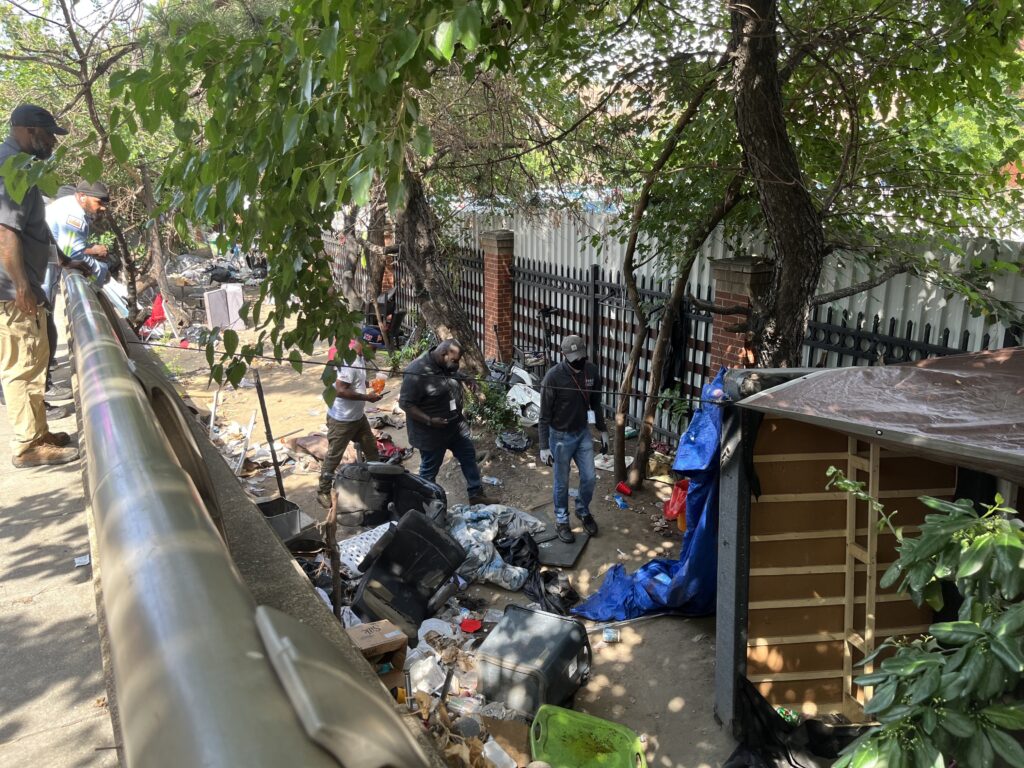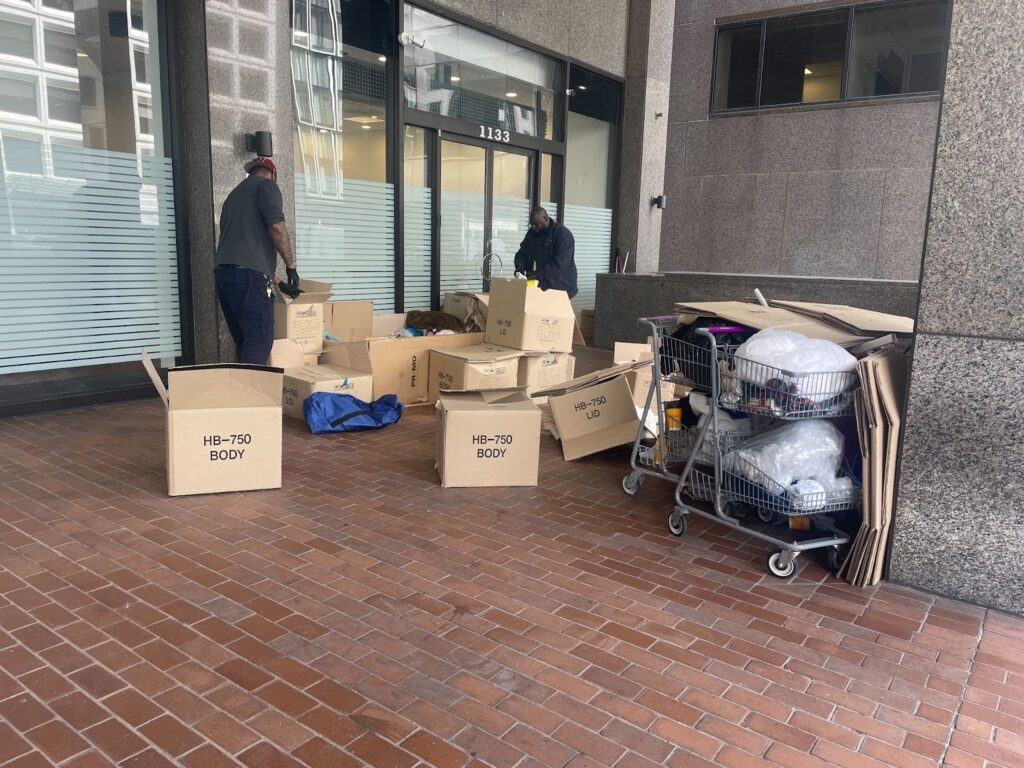The U.S. Interagency Council on Homelessness (USICH) — the only federal agency dedicated to preventing and ending homelessness — published a set of new guidelines last month directing municipal governments to be more thoughtful in their approach to addressing homeless encampments.
These guidelines come as communities throughout the United States grapple with how to address a perceived growth in the number of local encampments.
Unsheltered homelessness is a more visible problem than sheltered homelessness, which is on the rise, USICH Executive Director Jeff Olivet said. Requests for quick solutions in response, then, are not coming from advocates or people experiencing homelessness, but from the general public, the business community and people residing in nearby neighborhoods, according to Olivet.
“Where we see communities deviate from these principles, it’s when there’s such political pressure to act quickly,” Olivett said. “People are displaced from friends and connections and often from outreach teams that are attending to their health care and their other needs.”
2020 was the first year that more people experiencing homelessness lived without shelter than with it, the USICH reported.
Encampments garner frequent attention and interaction from local government entities who oversee encampment removals that displace homeless people.
Lori Smith, a vendor with Street Sense Media, has lived in several encampments in Portland, Ore. and D.C. According to Smith, living in an encampment can be tough especially when authorities attempt to remove people from them.
“I do see it is a problem that we have been criminalizing homelessness and poverty for so long. You take desperate people who will crack at some point due to the tremendous stress and suffering and misery that they’re experiencing,” Smith said. “It is miserable to be impoverished and homeless and houseless. And our main way of navigating that in our culture has been to incarcerate them, institutionalize them.”
The agency’s stated goal is to promote more humane encampment engagements by providing communities with guidance they hope will improve the way local authorities work with unsheltered homeless people. Olivet described encampment engagements as any local effort to interact with encampment residents. This includes outreach and providing services, as well as clean-ups and encampment dissolutions.
USICH recommends a “holistic community response” that involves local government officials, the homelessness response system, encampment residents, public housing authorities and law enforcement.
For instance, the agency recommends conducting outreach between encampment residents and potential services, involving encampment residents in determining how to resolve encampment disputes, and providing storage options to people who have nowhere else to store their belongings. They also ask that communities attempting to remove encampments offer residents access to alternative housing opportunities and develop pathways for them to obtain permanent housing.
But some homeless rights advocates think the guidance offered by the USICH is counterproductive. Aaron Howe, co-founder of the D.C. mutual aid organization Remora House — believes the guidelines ultimately promote encampment closures and are filled with inconsistencies
“I had a hard time with that document, because it is good on paper. I like a lot of what I’m seeing, but [there is] the underlying impetus of wanting to close the camp, and I can just see all the loopholes that different cities could use to say they’re following these progressive guidelines and are clearing camps,” Howe said.
Law enforcement involvement
People experiencing homelessness often have frequent and traumatizing interactions with law enforcement and many homeless rights advocates see this as a major oversight in USICH’s guidance.
The National Homelessness Law Center published a report in 2021 which states that many communities criminalize homelessness with laws and policies that forbid people from sitting, sleeping or eating in public.
“These laws and policies violate constitutional, civil, and human rights, traumatize homeless individuals and negatively impact their physical and mental health, and create arrest records, fines, and fees that stand in the way of homeless people securing jobs or housing,” the article stated.
Communities should designate law enforcement as a supporting partner for encampment engagements, according to USICH. This practice contradicts some advocacy organizations’ guidance of excluding law enforcement because their presence can escalate conflicts to violence and traumatizes people experiencing homelessness.
“We’re not going to get on board when your underlying goal is to remove these camps,” Howe said.
Olivet, however, believes that law enforcement does have a role to play in encampment engagement, particularly after sites have been cleared.
Input from people with lived experience
Historically, people with the lived experience of being unhoused have not been given a voice in how to address homelessness. USICH said it hopes to change that pattern by encouraging authorities to involve encampment residents in deciding how to “resolve” encampments.
“Too often decisions have been made about people without their input — and that’s especially true for people experiencing homelessness,” Olivet said. “I think when you do expand that table, and include more people who are closest to the problem, who have experienced homelessness themselves, then you get better solutions.”
Smith said that communities must deconstruct their biases against people experiencing homelessness in order for their input to be relevant.
“If you do not get familiar with the issues on the ground floor that people care about and you walk in with your biases, they will pick up on them very quickly, very fast. And they might not say anything, but those are matters of survival for someone who’s homeless, or these are threats to our existence,” Smith said.
The USICH guidance advocates for “meaningfully … elevating” the lives of the encampment residents through these principles.
Howe argued that this goal is better achieved through D.C.’s 2020 policy of trash-only engagements. In 2020, the CDC put out encampment engagement guidelines, advising communities to not displace encampment residents during a global public health crisis.
In accordance with these guidelines, D.C. decided to pursue minimally invasive clean-ups where encampment residents need not tear down and rebuild their homes during a cleanup; instead, they were asked what they wanted removed, and what they wanted to keep.
Racial disparities within homelessness
According to USICH, street outreach should prioritize the individual’s needs but ultimately put housing at the forefront of their support. The outreach should be trauma-informed, culturally sensitive and consider racial disparities within people’s living environments, according to the Department of Housing and Urban Development (HUD).
This can be accomplished through a Racial Equity Team that creates core goals and beliefs for all members of a homeless response team to follow, HUD elaborates. In addition, HUD suggests that encampment residents providing a perspective of lived-experience should be compensated for their time.
Many communities treat racial disparity as discrepancy in political belief rather than the product of systemic abuses. In 2021, Pew Research reported that 47% of Republicans believe that very little has to be done and 30% believe that nothing needs to be done to ensure equal rights for all Americans, regardless of their ethnicity or race.
Olivet said that communities that don’t recognize racial disparities in homelessness need to have a fact-based conversation about how people of color are dramatically over-represented in the homeless population.
How communities engage with encampments can further perpetuate racial inequalities, according to Howe.
“We’re seeing a huge increase in permanent addiction in camps, and heavy handed approaches: ticketing, citation. All of those things reinforce and reproduce racial inequality,” Howe said.
Procuring resources & housing
Smith said that unless permanent housing is provided, people are simply being shifted around. Their struggles with experiencing homelessness do not change, it simply becomes less visible to the outer community.
“They come into their camp, about 50% of them are served something to shelter or hotel or lodging and then they’re back out again because there aren’t any solutions — real solutions — waiting for them,” Smith said.
Homeless Response Teams and outreach workers should consider that encampment residents may be dealing with physical and mental illness, and thus require a variety of housing options to find a place of residence that accommodates their needs, according to HUD. Olivet said that a variety of housing accommodations include sobriety housing, multigenerational housing and shared housing.
Unfortunately, the current system of working with service providers and mutual aid groups to acquire housing is complex, Smith said, to the point that caseworkers can fail their clients due to an unnecessarily convoluted system.
Howe and Smith found the underlying goal of closing encampments to be an inherent flaw of USICH’s guidelines. Smith said that closing encampments in a flawed rehousing system will still lead to displacement.
“You’re putting the cart before the horse and you’re not prioritizing effectively, which begs my confidence in any of these propositions they’re making,” Smith said.








